
How to choose an acoustic piano (royal)?
Contents
If you’re into great sound and want to buy a real acoustic grand piano, you’ll need a hefty sum of money, a small living room, and a basic knowledge of grand pianos. The first two points are up to you, and this article will help with the last.
The name “piano” (from the French “royal”), received by him in Russia, emphasizes his grandeur and luxury like no other. This is the only musical instrument that has this ability to express the smallest nuances of the melody. Quietly and loudly, simultaneously and separately, abruptly and smoothly, several melodies at once – all this is not a problem for the piano. On the trumpet, for example, you cannot play ten notes at the same time, but on the piano all 88 is possible, it would be something!
History of the piano
The hammer action mechanism of the “keyboard king” cannot even be compared with the acoustic piano keyboard created in its own image (we are not talking about digital ones). Only the piano responds so sensitively to strikes of different speed and strength: for example, it transmits sound when you quickly press the same key again, the piano is not capable of this.
The arrangement of the strings and the dimensions of the instrument create a sound so powerful and deep that it does not need amplifiers in huge concert halls. Unlike the piano, it is more saturated in timbre , and the range of its changes is much wider.
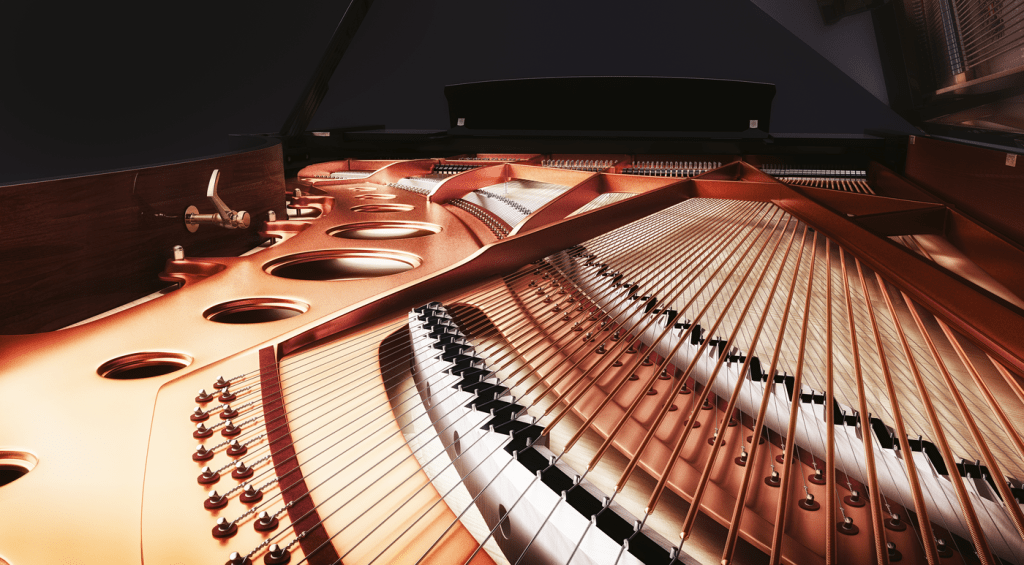
Grand piano “Bösendorfer” (Neustadt, Austria)
Thanks to the combination of these unique qualities, the grand piano has become an object of passion for true music lovers and an urgent need for professionals. Great works were created exclusively on the pianos and performance requires the appropriate. The piano is a kind of Rolls Royce in the world of music, and the price is right for it!
How to choose?
Given the high cost and a rather narrow circle of consumers, the range of brands, types and prices is amazing. Therefore, before choosing, it is worth understanding the subject as best as possible. We examined pianos from the point of view of who needs them and why. Based on your needs, you will be able to assess whether a “minion” for half a million is enough for you or if you still cannot do without a large concert grand piano. So what do you have to choose from.
For concerts:
Any musical institution, be it a school, a conservatory or a philharmonic, needs a piano, and more than one. For concert halls and the fingers of young talents, the best examples of piano craftsmanship are needed. Moreover, such institutions do not experience a deficit in space (and often in budgetary funds).
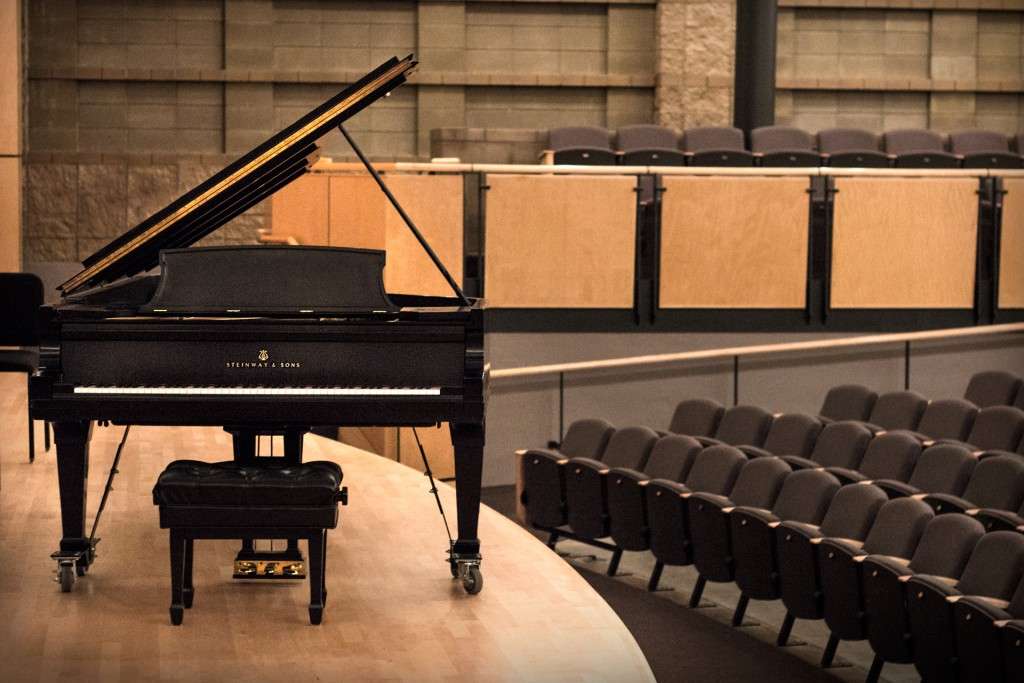
Grand piano “Steinway & Sons” (Hamburg)
The most demanding listeners are regularly served by concert grand pianos . These are instruments of the best sound and playing qualities, the most expressive in tone and depth of musical performance. Among them there are large (length more than 274 cm) and small (from 225 to 250 cm) concert; also sometimes include salon tools from 210 to 225 cm long.
When choosing the size of a concert grand piano, first of all evaluate the room where you plan to put it. A large concert grand piano (274-308 cm) will sound deep and expressive in any hall with an area of more than 100 m² and a ceiling above 3 meters. The weight of such a piano is approximately 500-550 kg.
It is worth noting that not only the volume of the sound, but also its quality depends on the size of the instrument. In accordance with the size of the body, the area of the resonant soundboard changes, as well as the length and mass of the strings. The larger the piano, the more beautiful, expressive and deep sound it has.
For home and education:
Not everyone has a hundred-meter room for music lessons. But you still cannot forbid a true admirer of beauty to play the piano. Especially for those who do not have their own ballroom, a cabinet grand piano was created .
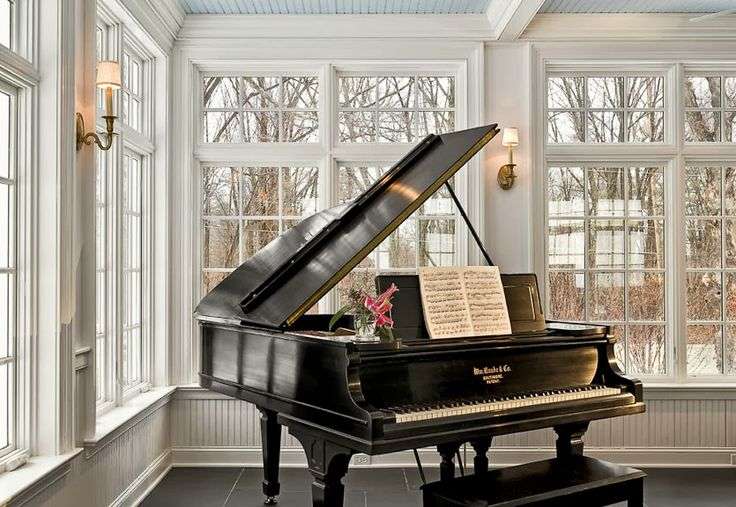
Cabinet grand piano “Wm. Knabe & Co.”
This is a small tool (length 160-190 cm), convenient for placement in the office – any room in a mansion, house, palace or large room in an apartment (how big the room should be, read below). In this it differs from the more full-sounding concert or salon grand piano, which was customary to put in a musical drawing room or ballroom. In the old days, cabinets were called rooms in the male half of the house, free for guests to access. Historically, cabinet (room) size grand pianos appeared in the 1820s and 30s, after Mr. Alpheus Babcock (an American) invented the so-called cross-string arrangement, which made it possible to constructively reduce the length of the body.
The sound and playing qualities of a cabinet grand piano depend on its length ( acoustics ) and class (select classes and brands below). The best are models with a length of 180-190 cm; when this parameter decreases, due to physical laws, the sound becomes worse: the smaller the size, the more significantly.
Why cabinet grand pianos are good: among them you can find both masterpieces of piano craftsmanship and fairly inexpensive models. For example, manufacturers such as Steinway & Sons, C. Bechstein, Shigeru Kawai produce premium cabinet pianos. And the Mendelssohn company produces “German” grand pianos at pleasant Chinese prices. At the same time, the art-déco appearance creates a good impression.
Another type of piano “for the house” is a minion (or mini-piano). This is an instrument of the most modest sound and playing qualities, minimal in length (132-155 cm), sound expressiveness and price – in comparison with other grand pianos. Created to please the market needs to have a good but small tool.
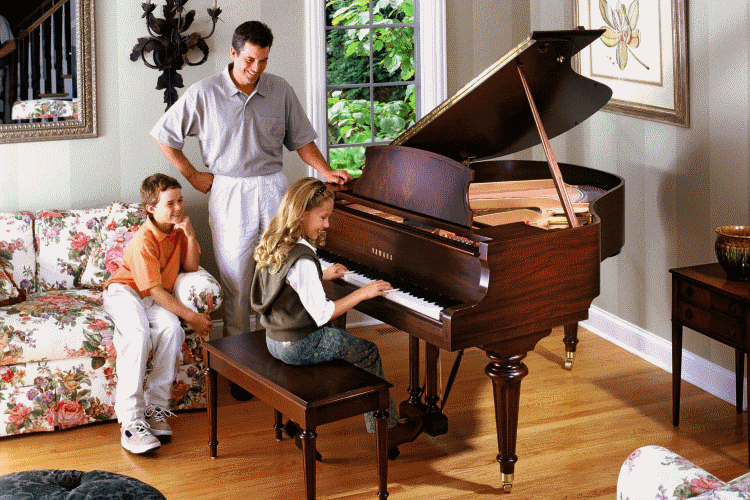
Piano baby grand “Yamaha”
American marketers have introduced the term “baby grand” (“piano for a child”). With this name, it is much easier to sell to parents who are ignorant of the intricacies of the musical qualities of the piano. In fact, the short length of the body of such a piano is achieved by reducing the resonant soundboard and the length of the strings; because of this, due to the physical laws of acoustics, the sound is “truncated”. Playing quality also deteriorates with a smaller body: shortened hammerstems (“sticks”) with hammers strike the shortened strings too quickly, reducing the range of tonal expression.
However, at the initial stage of training, this is quite enough. It is not yet clear how serious the kid’s passion for music is, and not everyone will allow themselves to clutter up the room with a two-meter “pedestal” for the love of art. In addition, a miniature grand piano, no matter how small, is still better than an ordinary and even less expressive piano.

Piano classes:
In terms of sound quality and manufacturing, pianos are divided into several classes – from premium pianos, which are made to order and sound in the best concert halls of the world, to low-budget Chinese instruments.
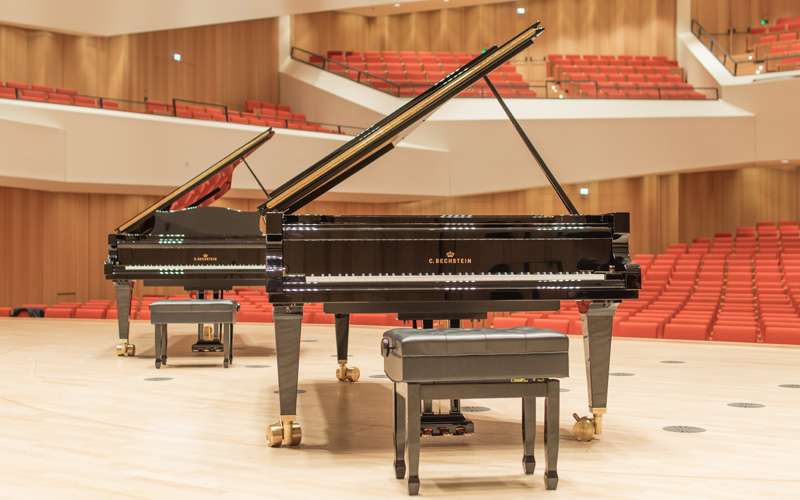
Grand pianos “C. Bechstein” (Seifhennersdorf, Germany)
Among the best of the best ( premium class ) are the models of such manufacturers (from 6,900,000 rubles to 11,000,000 rubles):
• Fazioli (Italy)
• Phoenix (Steingraeber & Söhne) (Germany – UK)
• Steingraeber & Söhne (Bayreuth, Germany)
• Steinway & Sons (Hamburg) (Hamburg, Germany)
• August Förster (Löbau, Germany)
• Blüthner (Leipzig ) , Germany)
• Bösendorfer (Neustadt, Austria)
• Grotrian-Steinweg (Braunschweig, Germany)
• C. Bechstein (Seifhennersdorf, Germany)
• Mason & Hamlin (Geverhill, USA)
• Sauter (Speichingen, Germany)
• Shigeru Kawai (Ryuyo, Japan)
• Schimmel (Konzert series) (Braunschweig, Germany)
• Steinway & Sons (New York) (New York, USA)
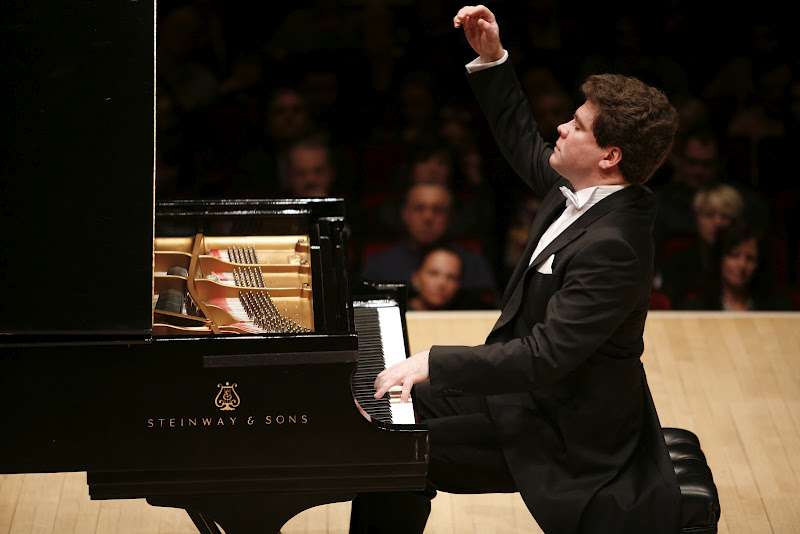
Denis Matsuev plays the piano “Steinway & Sons”
High performing class (from 2,700,000 rubles to 12,000,000 rubles):
• Haessler (Leipzig, Germany)
• K. Kawai (GX series) (Hamamatsu, Japan)
• Pfeiffer (Leonberg, Germany)
• Petrof (Hradec Kralove, Czech Republic)
• Rönisch (Leipzig, Germany)
• Schimmel (Classic series) (Braunschweig) , Germany)
• Seiler (Kitzingen, Germany)
• Yamaha (CX series) (Hamamatsu, Japan)
As a cheap alternative to premium models, you can buy a ready-made modernized (overhauled) grand piano of a well-known German brand. It is created anew with new figures of the mechanism , hammers, strings, pins and other premium components based on the body of an old piano (from 700,000 rubles to 5,800,000 rubles).
The less a piano costs, the simpler it is in design, the cheaper the parts, and the faster the manufacturing process. Although some components ( mechanism , hammers, strings and even soundboard ) can be of high quality.

Butterfly mini piano by Mendelssohn
The middle class includes original or hybrid models (from 700,000 rubles to 6,000,000 rubles):
- K. Kawai,
- kawaii ,
- Mendelssohn,
- Feurich,
- Kohler & Campbell,
- Knabe & Co.,
- Samick,
- Ritmuller ,
- Brodmann ,
- Irmler
Consumer class :
• S. Ritter,
• Elise,
• Hailun.
What room is suitable for a piano?
Whatever the acoustic grand piano, it is still quite an expensive purchase. Considering that this is also a complex sensitive mechanism , the question immediately arises of how to take care of it. Here are some simple tips for positioning and caring for your grand piano.
1. So that the piano sounds good, does not get lost in the room and does not jam everything around, choose the right room:
– the sum of the lengths of the sides of the room should be 10 times the length of the piano;
– open doors or windows improve the clarity of low-frequency sound perception;
– the ratio of the lengths of short to long walls and their lengths to the height of the ceiling should be 1:3 or 1:5;
– do not install the tail of the piano in the corner of the room;
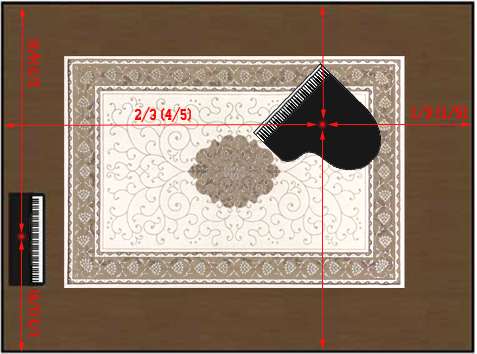
– put a carpet under the entire piano space to absorb excess sound;
– it is better to place the piano in a room with an uneven ceiling or in a trapezoid-shaped room (not parallel walls) than in a square room;
– put the piano with its left side to the window, while trying to avoid direct exposure to the rays;
– To absorb reflected waves, place bookcases, paintings, wooden blinds and similar objects in the room that are irregular in shape, thick, soft and with an uneven surface.

Piano “Samick” in the living room
2. To prevent the body from drying out:
– do not install the piano next to a radiator, a fireplace, an open window;
– avoid overheating in winter, use air conditioning in summer;
– monitor the air humidity, it should be around 42% (check the air humidity with a hygrometer and, if necessary, humidify the air with special humidifiers);
– do not use the piano as a stand for glasses, cups and water vases. Liquids can ruin the tool permanently.
3. To maintain the quality of the piano, call the tuner at least once a year. It will not only tighten the strings, but also control the correctness of daily care.

Wherever the piano appears, it creates a special atmosphere in which lively beauty and strict classics reign. A real royal instrument! True admirers of high art will not be stopped by either the price or the hassle. But if you are pursuing more practical goals, pay attention to unpretentious “analogues”: acoustic and digital piano , synthesizer and even digital grand piano . Each of them has its own advantages: basically, it is compactness, ease of use and maintenance, low cost, digital capabilities, etc. Read about them in our knowledge base .
Although, no matter how “convenient” modern improvements may be, they do not add a lively deep sound. True connoisseurs know this. And buy a piano.





